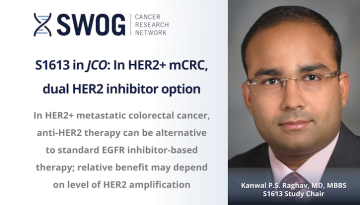Improving SWOG–Patient Communications
Patients are our absolute highest priority, at the heart of everything SWOG does. In fact, one of our recent initiatives was designed to improve the quality and quantity of our trial-related communications with patients.
This is our plain language initiative – our project to help better inform those who might be eligible for our studies, and their family members and other caregivers, about clinical trial opportunities. It’s moving full speed ahead with our recent hiring of a plain language medical writer. Her name is Amanda Stamplis, MPH, and she previously developed patient education materials for the MD Anderson Cancer Center.
Patient-friendly trial summaries
A key piece of this initiative is patient-friendly trial summaries, which will now be available for all new SWOG trials at activation. These overviews answer key questions to help patients decide whether they want to learn more about a trial.
Each summary is reviewed by the NCI’s CIRB, after which we post it to the SWOG website with an easy-to-remember address (for example, last week we posted a summary at swog.org/S1925). The online summary includes a link to a PDF version that you can print locally (usually on both sides of a single sheet of paper) and hand to patients or put in a literature rack. All summaries are posted to the CTSU website as well, so they’re available to all NCTN and NCORP sites that might open a trial, regardless of group affiliation.
We’re making these summaries available for new trials at activation, but we’ll be working over the coming months to develop them for our 40+ active trials as well, starting with those that are facing particular accrual challenges.
Social media toolkits
To get these summaries in front of the patients they’re meant for, we’re also rolling out a social media toolkit for each new trial at activation, complete with text and graphics. These toolkits feature CIRB-approved messages – some aimed at patients, others at health care providers – that can be posted to social media. SWOG will post these messages daily for two weeks after trial activation to our @SWOG Twitter account (now with almost 12,000 followers!). We encourage study team members to post them to their own accounts as well, and we provide a page of best-practice guidelines to help them do this. Our patient advocates are also using these resources to help raise awareness among advocacy organizations that connect patients to trials.
For our member sites, each toolkit also includes a CIRB-approved announcement they can post to their own social media accounts to alert followers that they’ve opened a new study. Any site’s social media team can simply insert their institution’s name into the text where indicated, grab one of the provided graphics, and post.
Logged in members can find the social media toolkits on individual clinical trial pages on the SWOG website – for example, swog.org/clinical-trials/S1925. Look under the “Other Study Materials” section for the toolkit and a .zip file that holds the graphics as separate .jpg images. The toolkits will also be posted to ctsu.org. As with the trial summaries, we’re currently providing toolkits for new trials at launch, but going forward we’ll develop them for our active trials too.
A website section for patients
In the coming days you’ll see additional new resources for patients on the SWOG website – under a “For Patients” item in the top menu bar. This new section will include content and links to help patients and their caregivers learn more about clinical trials. It will also feature a “Trials Open to Patients” search page that will provide ready access to the patient-friendly trial summaries described above.
More understandable informed consents
Finally, in addition to providing new materials to help patients learn about our trials, we’re also improving our existing patient communication materials. As our protocols move through development, Amanda is applying her expertise to make our informed consent documents easier to understand for patients enrolling to our trials. It’s hard to overstate the importance of making our informed consents more readable and more … well, informative for patients. This is proving to be an area where our new plain language writer is adding significant value.
In brief
Here’s the takeaway: look for patient-friendly summaries and social media toolkits with all new trials at launch (and eventually for all active trials). Look for a new patient section to the website to be rolled out in the coming days, and look for informed consent documents with our future trials that are better aligned to the average person’s health literacy skills. Finally, here’s a stretch goal for the future: plain language summaries of our trial results when they’re published! We owe as much to our patients.
Other Recent Stories



